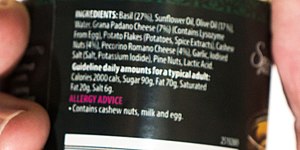Presbyopia
| Presbyopia | |
|---|---|
| Synonyms | the aging eye condition |
 |
|
| The small print of an ingredients list is hard to read for a person with presbyopia. | |
| Classification and external resources | |
| Specialty | Ophthalmology |
| ICD-10 | H52.4 |
| ICD-9-CM | 367.4 |
| DiseasesDB | 29647 |
| MedlinePlus | 001026 |
| eMedicine | article/1219573 |
| MeSH | D011305 |
Presbyopia is a condition associated with aging of the eye that results in progressively worsening ability to focus clearly on close objects. Symptoms include a hard time reading small print, having to hold reading material farther away, headaches, and eyestrain. Different people will have different degrees of problems. Other types of refractive errors may exist at the same time as presbyopia.
Presbyopia is a natural part of the aging process. It is due to hardening of the lens of the eye causing the eye to focus light behind rather than on the retina when looking at close objects. It is a type of refractive error along with nearsightedness, farsightedness, and astigmatism. Diagnosis is by an eye exam.
Treatment is typically with eye glasses. The eyeglasses used have higher focusing power in the lower portion of the lens. Off the shelf reading glasses may be sufficient for some.
Anyone over the age of 35 is at risk for developing presbyopia and all people become affected to some degree. The condition was mentioned as early as the writings of Aristotle in the 4th century BC. Glass lenses first came into use for the problem in the late 13th century. The word is from the Greek πρέσβυς (presbys) meaning "old man" and ὤψ (ops) meaning to "see like".
The first symptoms most people notice are difficulty reading fine print, particularly in low light conditions, eyestrain when reading for long periods, blurring of near objects or momentarily blurred vision when transitioning between viewing distances. Many extreme presbyopes complain that their arms have become "too short" to hold reading material at a comfortable distance.
Presbyopia, like other focal imperfections, becomes less noticeable in bright sunlight when the pupil becomes smaller. As with any lens, increasing the focal ratio of the lens increases depth of field by reducing the level of blur of out-of-focus objects (compare the effect of aperture on depth of field in photography).
...
Wikipedia
